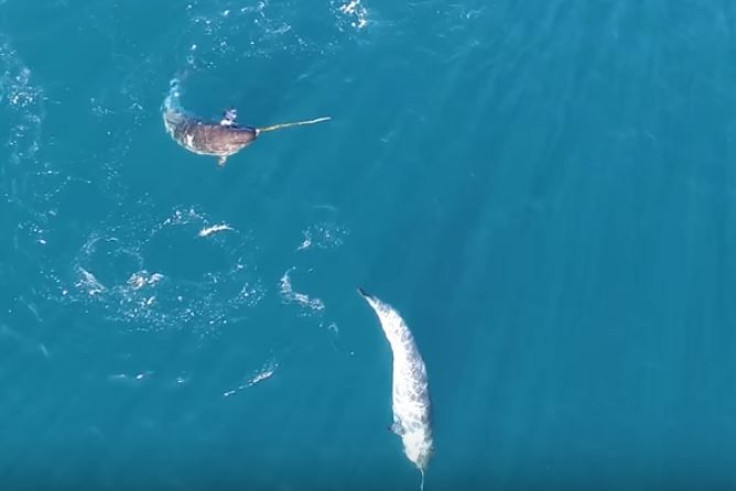Here’s What Those Narwhal Unicorn Tusks Are For: Arctic Whale Weapons

Scientists have finally figured out what the unicorn tusk on a narwhal’s head is for and it turns out it’s a weapon. Drone video footage caught the arctic whales using the long, spiraled tusk on their heads to smack and stun fish before eating them.
The World Wildlife Fund released the video (below) on Friday, and in it you can see narwhals slapping arctic cod with their tusk, so quickly that you could easily miss it and have to rewind. While the prey is immobile, the narwhal gobbles it up.
That tusk, which has earned it the nickname “the unicorn of the sea,” is actually an especially long tooth that can grow up to 9 feet long. According to the WWF, the behavior of using the horn to stun fish has never been caught on film before.
Read: Camera Hitches a Ride on a Humpback Whale
Previous theories on the use of the horn included fighting between males in a sort of jousting match.
“People have been trying to figure out the function of the narwhal tusk for a long time,” Brandon Laforest, senior arctic specialist for WWF-Canada, said in the organization’s explanatory video. “While there are some things we know about it — it is full of nerves, it likely has a sensory capacity and it’s not used for fighting — this footage has shown us a new feature, which is narwhal using it to catch fish.”
Hit, stun & eat. Researchers observe new narwhal behaviour! https://t.co/nC0v4Uk5VU #SeaUnicorn pic.twitter.com/Rv03Q7F6zA
— WWF-Canada (@WWFCanada) May 12, 2017
“Research like this will continue to shed light on the biology of narwhal and will lead to more information which we can use to make proper conservation decisions in the future to safeguard the species,” Laforest said.
The whales live in the arctic waters surrounding Canada, Greenland, Norway and Russia. According to the WWF, narwhals can grow to 17 feet long and can weigh up to 4,200 pounds. They eat fish like halibut as well as squid and shrimp.
Narwhals are born with a grayish color but turn black when they mature. The elderly narwhals have white streaks or turn nearly completely white.
Read: Mysterious “Hairy Blob” Could Be Decomposed Whale
Males are often the ones that have the tusks, but some females also sport the facial appendages. When the tusk appears, it is one of only two teeth — the left one. “In most males, the right tooth remains embedded in the skull,” the Canadian governmental organization Fisheries and Oceans Canada explained. However, some males rarely have two outward tusks.
“They seem very agile with their tusk, when you watch the video,” Fisheries and Oceans Canada’s Marianne Marcoux said. “They can flip the fish in very agile ways, so what’s very exciting to me is like what else can they do with their tusk?”
© Copyright IBTimes 2024. All rights reserved.











